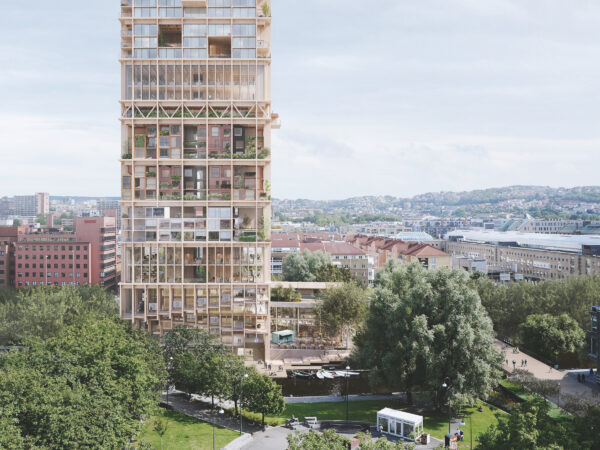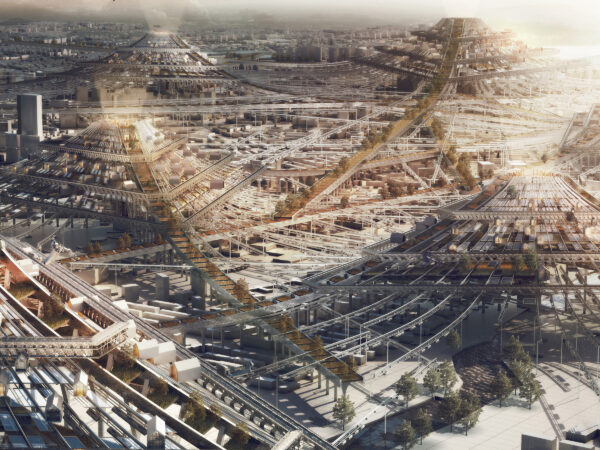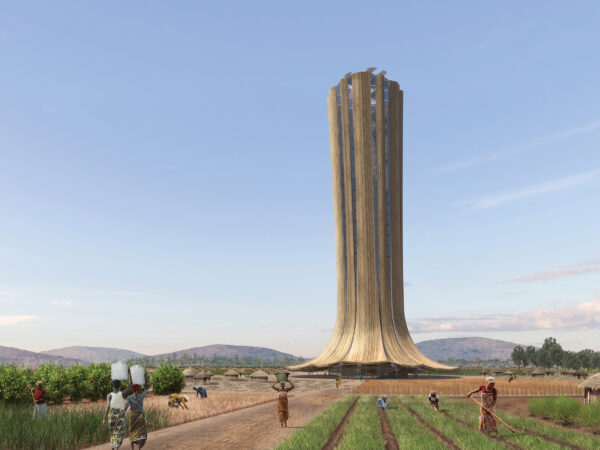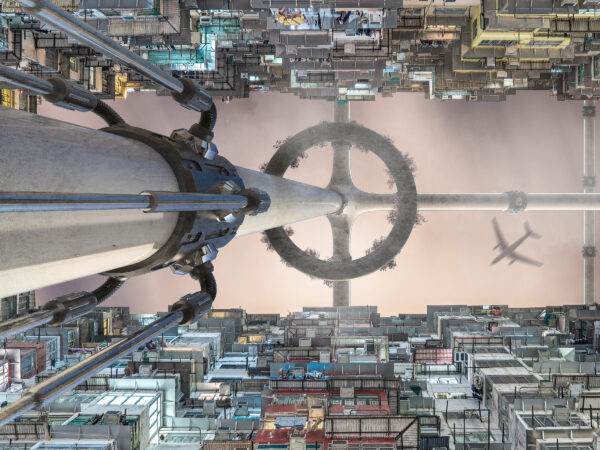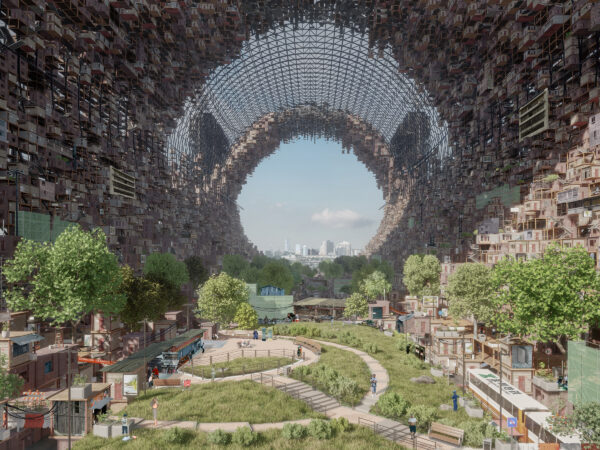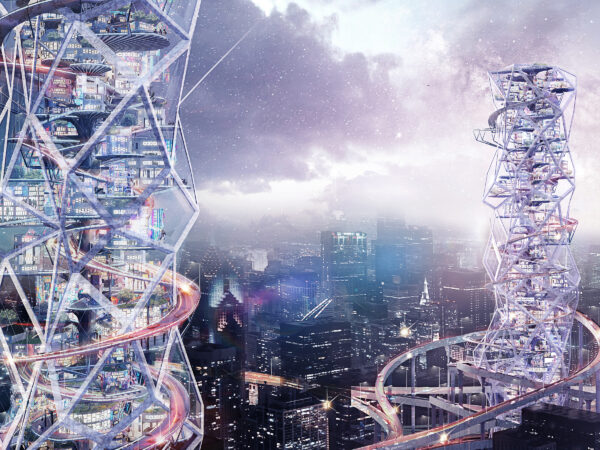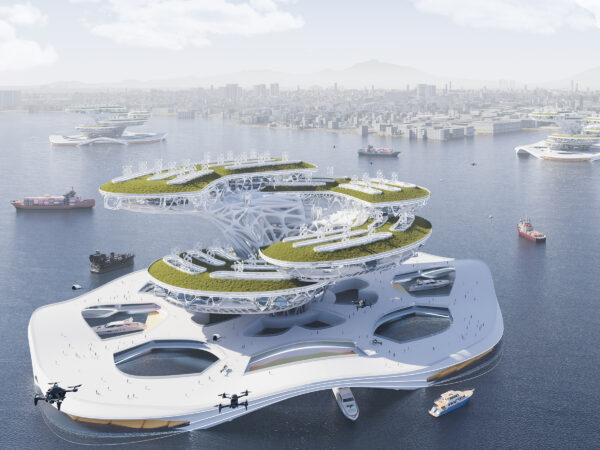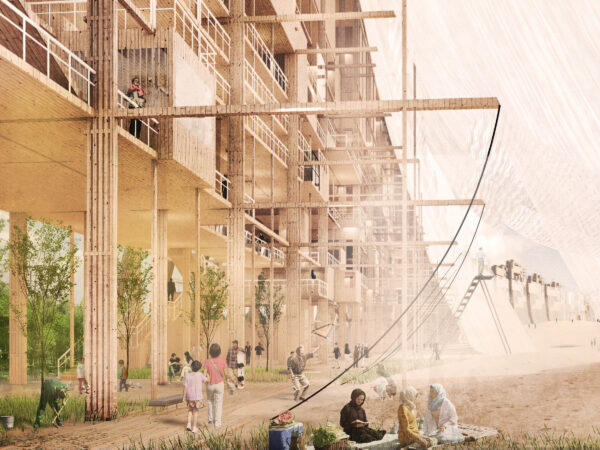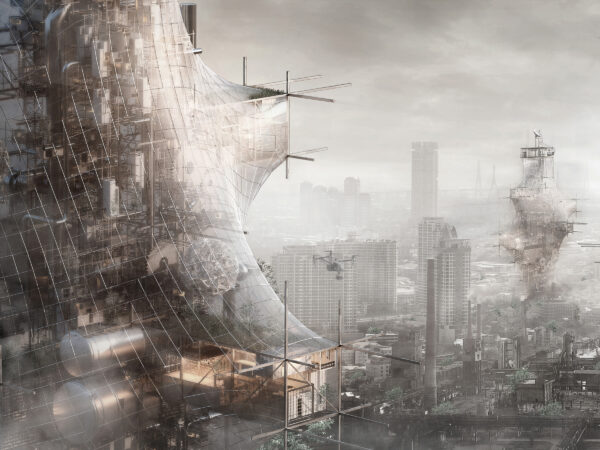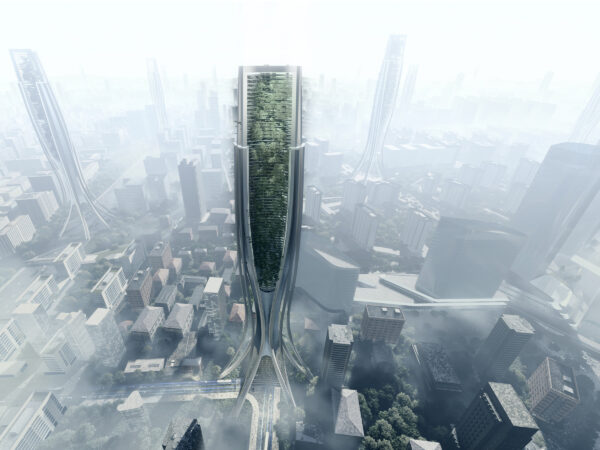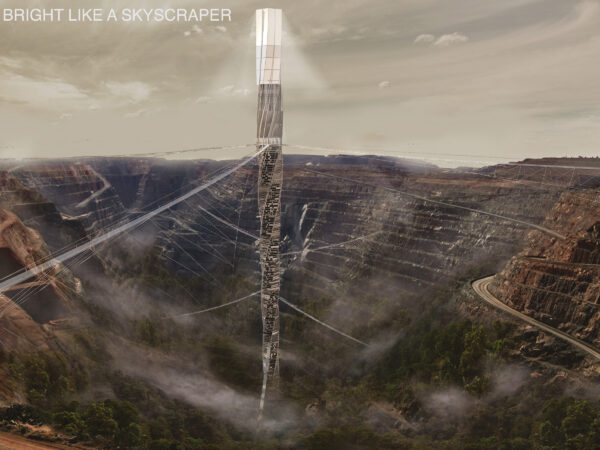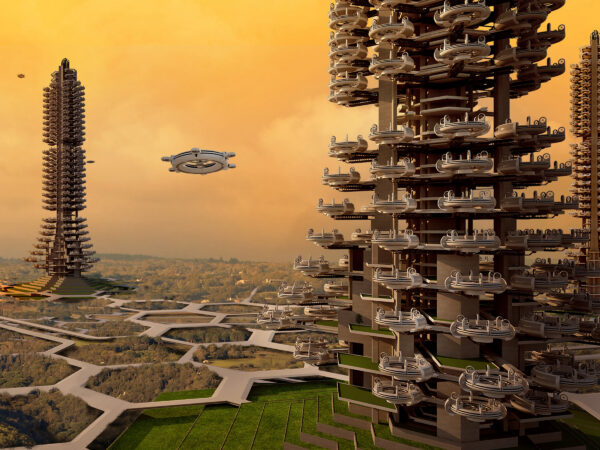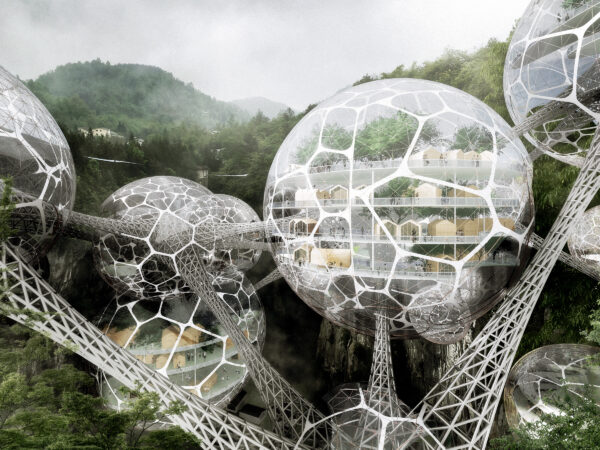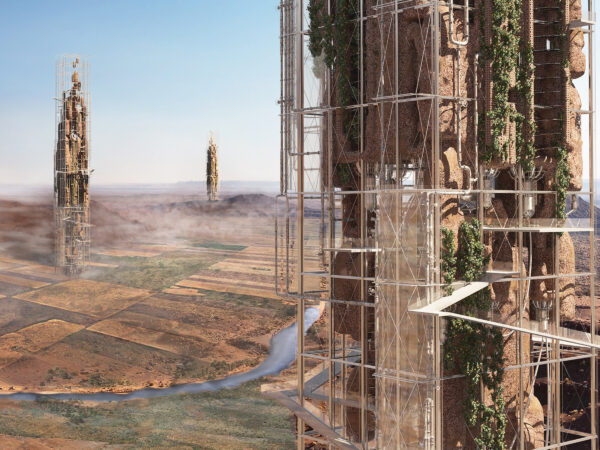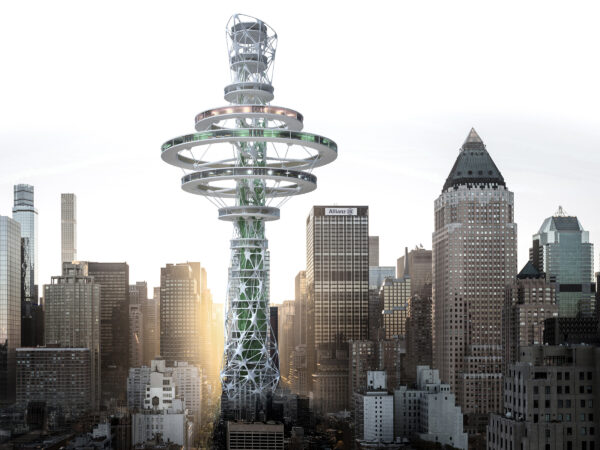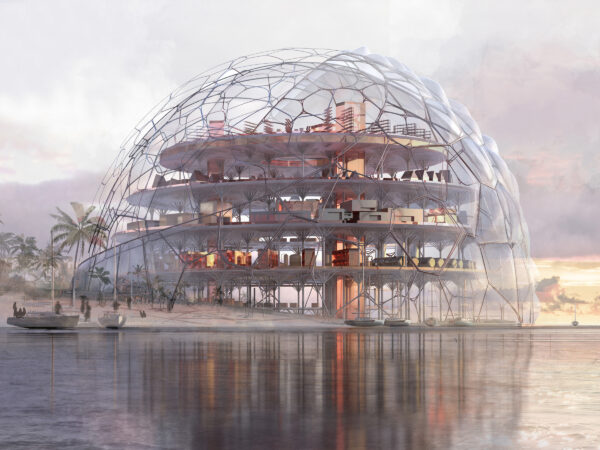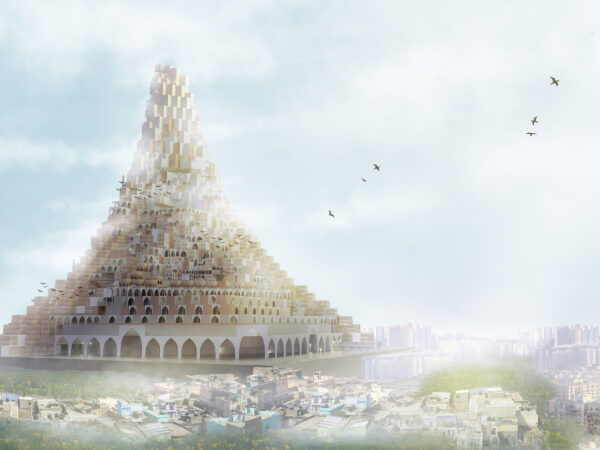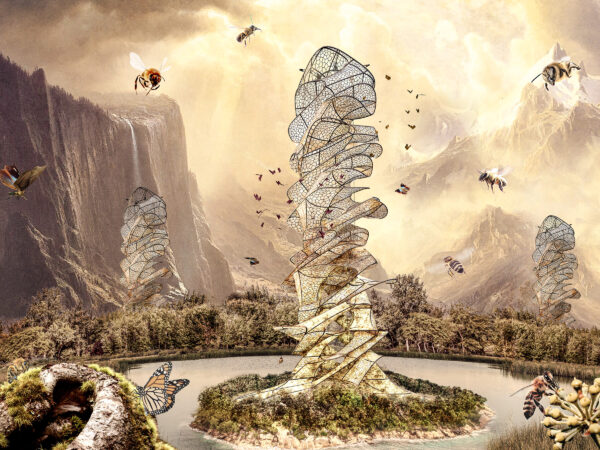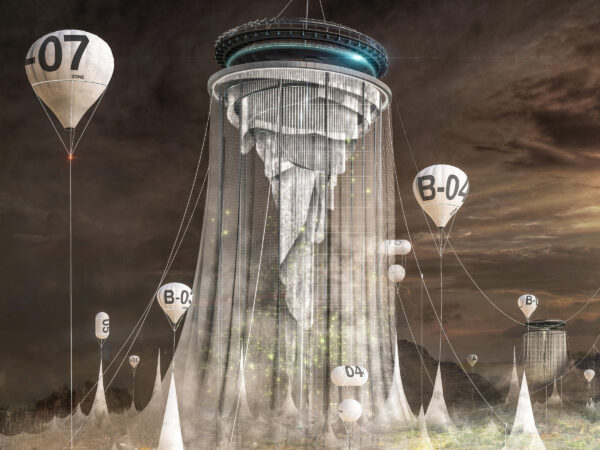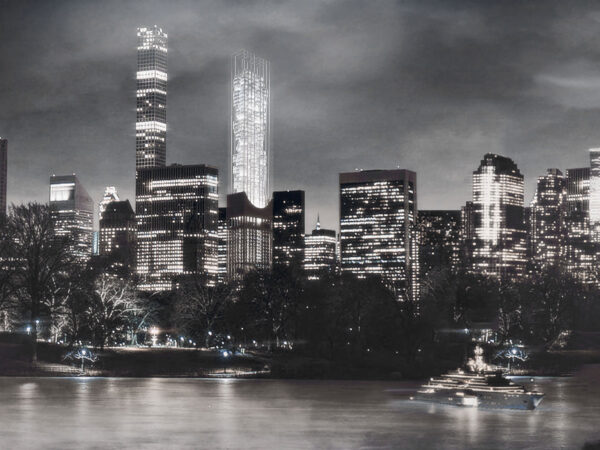Regenerative Highrise
Honorable Mention
2022 Skyscraper Competition
Haptic Architects, Ramboll
Tomas Stokke, Shonn Mills
United Kingdom, Singapore
The Regenerative Highrise is sited at Grønland, a multi-cultural inner-city borough of Oslo.
The proposed new highrise tower at Oslo’s Grønland metro station seeks to use large-scale development of the city as a means to repair or enhance the inner-city neighborhood. In the first instance, this is a site of unique potential, where the metro meets the river above and its adjacent cycle and riverwalk. As such the new tower becomes a vertical linkage of these existing and developing transport networks, most notably the increased use of the city’s waterways for electric ferries.
The tower structure reuses an existing highway viaduct at its base, creating active frontages spanning three levels: the canal and metro level; the high street, and the viaduct level. The base of the tower gives back to the city, providing cultural, leisure, and sports facilities for the inhabitants of the city. The highway viaduct is repurposed for leisure purposes, to ensure the embodied carbon of the existing structure does not go to waste.
The tower itself seeks to address the challenge of waste in the construction industry. Changing needs and standards often lead to relatively new buildings being demolished and rebuilt. The proposed tower employs regenerative design at its core, thus ensuring future flexibility for change.
A superstructure consisting of 3-story high structural decks, allows the tower to be reprogrammed over time. The triple-height sky villages are flexible and can accommodate a variety of uses, such as a single-story production space, two stories of office space, three residential floors, or even a row of terraced housing. Read the rest of this entry »
Urban Bypass Surgery
Honorable Mention
2022 Skyscraper Competition
Yi Liu, Baichao Wang, Hao Zhang, YiHui Gao, ZongHao Yang, Shiliang Wang
China
Changchun is one of the most important cities in China. At the beginning of the last century, urban designers of Changchun carried out the road network system with reference to the theory of Howard’s “Garden City”. The urban transportation in Changchun is a system formed by multiple city squares as the center and roads as the axis, which initially established the main roads in the urban area of Changchun, and this urban layout is still in use today.
With the economic development and population growth of Changchun, the advanced urban transportation system can no longer meet the needs of the city. Although the city square connects several main urban roads, it is very easy to cause traffic jams in the surrounding area of the square during the peak urban traffic hours. For many years, Changchun is one of the cities which has the highest urban traffic jam rates in China. The main framework of the city cannot be changed, and we urgently need to create a new method and model to solve this problem.
This design distributed a number of transportation centers in the busy urban squares in Changchun. The interior of these transportation centers includes an urban cable car system that extends in all directions, a three-dimensional green landscape, and a number of residential and commercial space units. People gather here and take the cable car to any parts of the city. The vertical green landscape system can absorb the automobile exhaust air. The movable and detachable residential and commercial units enrich the center’s commerce system and provide citizens with a convenient urban life. Read the rest of this entry »
Tree Skyscraper In South Sudan
Honorable Mention
2022 Skyscraper Competition
Ron Krakovski, Talia Tsuk
Israel
The main purpose of The Tree skyscraper is to provide accessible water to the villages of South Sudan. The Tree unifies the new community while providing it with water for agriculture, sanitation, and everyday needs.
South Sudan is located in northeastern Africa; it gained independence from the Republic of Sudan in 2011, making it the latest nation to be recognized by the United Nations. Conflicts have undermined the developmental gains achieved since independence and worsened the humanitarian situation. As a consequence, South Sudan remains caught in a web of fragility, economic stagnation, and instability a decade after independence. Poverty is ubiquitous and has been reinforced by a history of conflict, displacement, and shocks.
59% of the population of South Sudan lack proper access to clean water sources. Constant conflict and civil war, which began in 2013, Have led to the current water crisis in South Sudan. During the war, the nation’s water systems were deserted and demolished. 1 in 3 people use contaminated water daily, increasing the risk of infection by waterborne diseases. Currently, in South Sudan, 77% of children under the age of five die from diarrhea. Read the rest of this entry »
Connecting Skyscrapers In Hong Kong Through Infrastructure
Honorable Mention
2022 Skyscraper Competition
Zheng Xiangyuan
China
The population of Hong Kong has shown a continuous growth from 7,185,996 in 2015 to 7,496,981 in 2020. People have built skyscrapers in order to create more space on limited land. In the beginning, skyscrapers do provide more space for people, but with the increasing population, the number of skyscrapers will continue to increase, and eventually, they will fill the land of Hong Kong. How are we going to create new space for people to use when we can’t build new skyscrapers anymore?
Hong Kong is one of the cities with the highest population density in the world, its population density is 23.8 times the optimal urban population density. Only 1,106.66k㎡ of land carries 7,496,981 people, Nearly 80% of them live in coastal areas, which make up only 15 percent of Hong Kong’s total area. Over the past decade, Hong Kong’s population has grown by an average of 0.8% per year. Hong Kong faces a very serious population problem. As the population continues to increase, the average living space of people will continue to decrease. How to create more space in a limited area has become a serious problem for us to think about. Read the rest of this entry »
Urban Condenser
Honorable Mention
2022 Skyscraper Competition
Yunheng Fan, Baoying Liu, Rongwei Gao, Junliang Liu
China
Urbanization is an important symbol of a country’s transition from a backward agricultural society to modernization, and China is undergoing an important transformation of urbanization. Migrant workers, a discriminatory and self-contradictory title, deeply reflect their status of “marginal people,” the main force of urban construction in China. They work in cities but do not have urban hukou, or household registration, and do not enjoy social security. They make great contributions to the city, they yearn for the city, but are not accepted by the city and are free from mainstream society.
The migrant worker community gathers these workers (often called “drifters”) together and the collective living allows them to gradually blend into the society. At the same time, the Urban Condenser serves as a cohesive device for the city, allowing urban residents and migrant workers to intermingle. With community, city, migrant workers, residents, and other dimensions of identity as the object, and with lifestyle, tourism, community mechanism, and other connections within the community as the link, the Urban Condenser builds a “super community” to stimulate social development. Read the rest of this entry »
City Healer Skyscraper
Honorable Mention
2022 Skyscraper Competition
Wang Changsi, Guo Fang, SiYuan Zhang
China
With the continuous expansion of the city scale and the continuous increase of the population, the “urban diseases” that are similar in the major cities have appeared. This design focuses on the problem of urban ecological distribution and utilization. The architect hopes to make the city natural through his own design. The organic combination of ecology and urban human ecology will form a self-sufficient urban ecological system that can make full use of clean natural energy to realize residential, office, commercial, and transportation activities.
The design is firstly designed as a single unit based on the needs of residents and is divided into two main functional systems: commercial and residential. The monomers in the two systems are designed separately, but they all follow the same rules: the spatial arrangement of the monomers is carried out through a parametric program, and all the monomers will be logically searched for their 3D spatial positions: 1. The secondary monomers are directed to Higher-level monomers that are close together, 2. The same monomers keep a sufficient distance, 3. There is a minimum distance between different monomers. Through these three logical building units, it will find its own reasonable position in the space. When the two systems are stabilized, structural reorganization is carried out to form a new complete system. Read the rest of this entry »
FUNG(S)I: The Vanguard Of Habitat Restoration
Honorable Mention
2022 Skyscraper Competition
Christopher Tanihaha, Vincentius Kevin Aditya, Arnetta Hamijoyo, Christina Putri Larasati, Evan Januar, Gavrila Mandy Kahuni, Eugenia Jessica, Felia Alexandra Linoh, Luciana Augusta, Gregorius Christian, Reynaldi Daud
Indonesia
Sinking land has become inevitable. It is mainly caused by the increase of seawater level and got worse by the decreasing underground water table that is happening simultaneously. Sinking land causes land scarcity which makes coastal residents around the world lose their homes. According to BBC News in 2018, the fastest-sinking city in the world in Jakarta, Indonesia. Jakarta is sinking by an average of 1-15cm a year and nearly half the land now sits below sea level. The dramatic rate of sinking is partly down to the excessive extraction of groundwater for drinking water and everyday hygiene purposes by city dwellers. Piped water is not reliable and hardly available in most areas so people have no choice but to resort to pumping water from the aquifers deep underground. So the main goal is to be a buffer that acts as a vessel for ex-dwellers of the sinking city that also provides potable water for the remaining citizens on land at the same time. Read the rest of this entry »
Cure For Desertification Skyscraper
Honorable Mention
2022 Skyscraper Competition
Wanjing Wang, Zhenhao Chen, Minghui Sang, Xiaoran Xiong, Kaifeng Fan
China
According to reporters, Dunhuang’s first and last green barrier against sand storms run by Dunhuang Yangguan forest farm, which once owned about 20000 acres of Forests belt, has encountered large-scale “shaved head” in recent ten years. The sweat of several generations of local people have wasted, and the ecological disaster of “green retreat, sand advance, desert pressing” reappears in Dunhuang.
All the protective forest lands cut down in the forest farm are used to plant grapes with high water consumption and frequent disturbance of the surface soil layer. At present, grape production has become the pillar industry of the forest farm. However, the problem is that after planting grapes, it will not only fail to prevent and fix sand but also may consume the scarce water resources and aggravate the risk of desertification.
So we come up with the consumption- how can we galvanize the local economy and achieve the betterment of people’s lives without aggravating sand storms and harming present forest barriers through the form of skyscrapers? Read the rest of this entry »
Hyper-Mask Skyscraper
Honorable Mention
2022 Skyscraper Competition
Yu Liu, Junjie Hou, Jiaxi Shi, Hailin Wu, Ronghui Yang, Jiang An
China
Before the COVID-19 pandemic, masks were one of the most reliable and direct methods for people to deal with urban air pollution; in the past two years, with the outbreak of the COVID-19 pandemic, the portability of masks and their impact on blocking the entry of air through breathing makes it a must-have for people traveling.
With the development of China’s industry, the frequency of China’s urban PM2.5 index exceeding 400 has increased. Masks can effectively reduce the number of harmful substances people inhale when exposed to a high PM2.5 index.
The extensive use of disposable masks also brings pollution problems. First of all, the raw materials of masks are mainly non-woven fabrics made of high melting index polypropylene materials. This material is derived from petroleum, which will cause air pollution during the production process; secondly, waste masks will flow into the sea with rainwater without incineration, threatening the marine ecological balance.
Building space has been a place where human beings gather to engage in production and living since ancient times. How to reduce the pollution of masks to the environment while making more people less affected by COVID-19、PM2.5 and pollution through architectural design? Read the rest of this entry »
Air Purification Skyscraper
Honorable Mention
2022 Skyscraper Competition
Zelun Wang, Shengwu Fan, Manqian Lin
China
The Problem
Nine out of 10 people around the world breathe polluted air, according to a report released this year by the World Health Organization. Indoor and outdoor air pollution causes 7 million deaths worldwide each year and is responsible for 24 percent of stroke deaths, 29 percent of lung cancer deaths, 25 percent of heart disease, and 43 percent of other lung diseases. Air pollution has become a major killer of human society.
Site Selection
More than half of the world’s most polluted cities are in India, with New Delhi firmly in the top spot. Pollution kills countless people in New Delhi every year. Especially in winter every year, PM2.5 index reaches 20 times the safe limit.
The Solution
We believe that the ban and school closures issued by the Indian government cannot fundamentally solve the problem. Cities still need to develop and operate, and the generation of PM2.5 should be stopped at the source. We blame, therefore, the most serious pollution source——traffic pollution, traffic intersection are set on the city air purifier skyscrapers, the generation of PM2.5 four kinds of reaction gas absorption and filtration, prevent reaction PM2.5, at the same time can also be useful, useless to the construction of power supply, to fertilize the vertical greening, The whole building forms a closed system to purify and regenerate polluted air. Read the rest of this entry »
Skyscraper For Open Pit Mines
Honorable Mention
2022 Skyscraper Competition
Sacha Cudré-Mauroux, Nils Hayoz, Bart Oosterhoff, Thomas Wenzel
Switzerland
The problem
Loss of Earth’s surface
With more than one hundred open-pit mines in the world, a large area of the earth’s surface is unusable after closing.
The loss of a city’s identity
Our skyscraper was designed for the pit mine of the Australian city of Kalgoorlie. This nineteenth-century city was created and shaped by gold mining and to this day the entire economy and identity operate on the mining of gold and nickel. When the mine is exhausted, and it is no longer profitable to continue the mining process, Kalgoorlie will have no future and will lose its identity. Read the rest of this entry »
Residential Flying Unit Nest Skyscraper
Honorable Mention
2022 Skyscraper Competition
Mohammad Pirdavari
Portugal
The construction of a villa is considered a great way to facilitate vacation accommodations for any family, to easily frequent their trips. Site locations for villas are most of the time, a place in the heart of pleasant natural resources, which construction of a villa, would ruin the existing ecosystem. In addition, having a traditional villa will cost a fortune, which is multiplied considering the fact that people want to idealize their villa, as their dream house! Limitations of the construction industry, in terms of land use, and lack of access to distant places, are also insurmountable. These are all just a gist of the reasons why the construction of a villa should be revised meticulously. This design of mine is a state-of-the-art, idea, which is a great way to overcome these challenges and create a new exceptional viewpoint. A self-sufficient, flying unit, creates a totally different living experience for the residents, in which they are free to choose their ideal climatically destination, no difference how high or low, how cold or warm! An ideal accommodation, which does not add up the expenses, because it gets charged via the solar cells of the facade, and also via the connected nest. A brilliant, eco-friendly, idea that tears down mental barriers as well as economic and environmental limitations. Read the rest of this entry »
Skyscraper Injects New Life To Tiankeng
Honorable Mention
2022 Skyscraper Competition
Shuzhan Liu, Siang Duan, Yimin Gao, Jingyi Li, Shiliang Wang, Daxu Wei
China
The design site is located in a Tiankeng in Shaotong City, Yunnan Province, where villagers have lived for generations. According to a legend, the ancestors of the villagers in Tiankeng lived here in order to avoid war. With the development of the times, problems gradually emerged, causing many inconveniences to the local villagers.
Local dilemma
Residents have a low standard of living and lack infrastructures such as education, medical care, and culture.
The industrial system is monotonous, and the industrial system needs to be optimized.
The development of urbanization and the emigration of villagers have caused the traditional village to be on the verge of extinction.
The outlying location and inconvenient transportation restrict economic development. Read the rest of this entry »
Adobe Farm Skyscraper
Honorable Mention
2022 Skyscraper Competition
Hamidreza Esmailnazari, Hosein Mosavi, Amir Hossein Saeedi Majd, Hossein Amery, Hossein Arshadi Soufiani, Ali Jamali, Maryam Baharvandi
Sweden
Isfahan is a city in the middle of the desert in Iran and it is situated on the north side of the Zayandeh River. The city retains much of its history, which has developed between the 9th and 18th centuries. It is famous for its Persian architecture and its history.
For centuries Isfahan city had been an oasis settlement, by dint of its surrounding fertile lands and prosperity. After the 1980s, the demand for water for industrial usage has raised gradually. The creation of large steelworks and other new industries along with the growing population, disable the scarce water resources to be utilized primarily for agriculture and now, the Zayandeh River cannot supply all the agriculture’s land anymore. The farmers in Isfahan have protested against the diversion of water from the Zayandeh River to supply other areas, leaving their farms dry and threatening their livelihoods. The violent crackdown on protests was answered to them by the government in 2021. From another point of view in this historical region, which has extreme weather, architecture ways widely used for finding passive ways to solve relation between humans and nature. These architectural ways are bound with the culture and identity of the local people. Their lifestyle has formed inside different types of shelters to protect them in extreme weather situations. Read the rest of this entry »
The City Chloroplast: A Skyscrapers That Absorbs CO₂ And Converts It Into Starch
Honorable Mention
2022 Skyscraper Competition
Kaiyu Chen, Yong Lin, Ziyi Li, Zhipeng Tao
China
Over the past years, the environmental issues due to carbon emissions have been the focus of many countries around the world. The emissions in North America and Europe have been stable, while the developing countries in Asia, South America, and Africa are facing increasing air pollution problems with economic growth and urbanization.
Similar reasons caused the increased carbon concentration in different countries. Rapid urbanization brings a higher demand for electricity and heating, and the CO₂ emissions from electronic appliances/equipment and transportation are the major sources of carbon emission.
In order to address the environmental issue due to greenhouse gas emissions, and to improve our living conditions, different countries are applying various methods to eliminate carbon emissions and improve air quality. The Chinese government is advocating the carbon emission control policy, proposing the strategic goals of “Carbon Peak” in 2030, and “Carbon Neutrality” in 2050. Read the rest of this entry »
Sanctuary Above The Tomb: Inhabiting Radioactive Marshall Islands
Honorable Mention
2022 Skyscraper Competition
Xueer Wang
China
The inhabitants of the Marshall Islands are the most direct victims of the two major threats facing humanity-nuclear weapons and climate change. Between 1946 and 1958, the United States detonated 67 nuclear bombs on, in, and over the Marshall Islands, expelled hundreds of people from their homes, and buried more than 3.1 million cubic feet of radioactive soil on one of the atolls, covering it with cement-forming what the locals call “The Tomb”. For decades, the residents of Marshall depended on foreign aid to survive.
Nowadays, climate change and sea-level rise not only accelerate the leakage of radioactive materials but also bring new threats to these indigenous people. a self-sufficient community system that provides clean water, food, and adequate infrastructure must be provided to the local residents. Read the rest of this entry »
MERU: Center For Organic Parallel Development
Honorable Mention
2022 Skyscraper Competition
Karan Jain, Vishwal Ram Gowda
India
Meru, it means the abode of gods at the center of the universe, the project brings together the context with those inhabiting it. The goal is to create organic growth within a community by the usage of progressive improvements, sort of like how a frog doesn’t realize its being boiled in water.
Currently in Delhi, among many problems is the incredulous amount of waste that is produced by the city and in tandem with that, its relation and allocation with the slums of Delhi. Among the two the former isn’t being given enough treatment and the latter seems impossible without the displacement of a large population of people. After contemplation one thinks that such a feat is impossible without there being the availability of such a large vacant amount of space. But what one, can do in such a situation is to set up a situation of parallel organic growth, this allows for the infrastructure to creep into an area with such rich culture and history while also allowing the area to creep into the infrastructure allowing for both the former and the latter to develop off of each other, pushing the development of the context at an exponential rate.
To achieve this the context and the people within should be able to feed off of each other, and so the MCD dump yard in Bhalswa new Delhi seems like the perfect site as the dump yard has been accumulating waste for a long time and as such depreciating the value of anything around it, which in turn made it ideal for laborers and slum dwellings to develop. Read the rest of this entry »
Beeswax Skyscraper: A Tower Made By Cooperating With A Swarm Of Bees
Honorable Mention
2022 Skyscraper Competition
Chien-Ching Su
Taiwan
Insects, accounting for 80% of animal life on Earth, are the most diverse and largest group on Earth. However, both their diversities and numbers are declining around the globe due to habitat loss, pollution, and climate change. Without effective conservation measures, not only food shortage becomes serious because lots of pollinators disappear, but the whole ecological balance on the planet will break. The main goals of the project are to conserve insects’ diversity and restore their population. With artificial frameworks and the help of bees, the high-rise structure will be built as an insect habitat.
The inspiration for the design comes from a Slovakian Artist, Tomáš Libertíny, who cooperates with a swarm of bees to create many striking sculptures. The most famous beeswax sculpture in his works is the Nefertiti bust, finished by 60,000 bees cooperation. The question is – how does he produce these works “made by bees?” Firstly, he prints a 3D artificial framework of the sculpture, which encourages bees to build their hive above the framework. Then, he spreads some sugar to help worker bees work efficiently. After a while, bees will complete a striking sculpture made with beeswax. Read the rest of this entry »
OASIS-Æ2030: Desertification Restoration Protective Membrane
Honorable Mention
2022 Skyscraper Competition
Han-Yu Lai, Wei-Qun Cai, Chun-Yi Yeh
Taiwan
In 2008 the FAO reported that 20% of all cultivated areas, 30% of forests, and 10% of grasslands are degrading. 52% of the land used for agriculture is moderately or severely affected by soil degradation and 12 million hectares of once productive land are lost to desertification per annum. Nearly 1.5 billion people depend directly on degrading land for their livelihoods, most of them in the so-called ‘developing world’. Land degradation leads to food insecurity which can, in turn, lead to conflict, migration, and inevitably, the loss of biodiversity. Less tangible, but no less significant is that the process of degradation not only erodes the land, it also corrodes the spirit of communities watching their homelands turn into a wasteland. Read the rest of this entry »
Adapting Obsolescence
Honorable Mention
2022 Skyscraper Competition
Ahmed Helal
United States
Since the construction of the Equitable Life Assurance Building in 1820, the office tower has become synonymous with white-collar productivity in New York City. In the subsequent 200 years, some 450 million square feet of office space has been constructed in the five boroughs, constituting over 10% of all office space within the United States. It wasn’t until the proliferation of the internet, collaborative communication platforms, and co-working spaces, that the office began to decentralize. Then, in 2020, the Global Coronavirus Pandemic completely disrupted the corporate hierarchy, as White-Collar America transitioned to working from home, it became evident that the workforce could remain productive outside the office. It is now clear that there will never be a full return to pre-Covid workplace normalcy. This paradigm shift has rendered the commercial office tower obsolete. If this typology no longer holds value, then what should we do with the obsolete building stock? To simply demolish it would be wasteful, arrogant, and short-sighted, for two reasons. First, all constructions have inherent value simply in that they exist and were an expenditure of finite resources that can never be replaced. To dispose of them is to erase those resources forever. New York City alone produces over 3 million tons of construction waste annually, only 35% of which is returned to the production stream. Second, it is precisely this outdated building stock that gives New York its identity. The only path forward is adaptive reuse – to transform these antiquated buildings into vibrant and essential structures that serve to alleviate the two fundamental architectural crises in the city: housing and public space. – This proposal is an example of adaptive reuse design, changing landmarked office skyscrapers like the AT&T Building by Philip Johnson, currently known as 550 Madison, to residential spaces that prioritize tenants and the local community, offering an accessible well-rounded live, work, and play lifestyle through the design and programming of homes and public spaces. Read the rest of this entry »
